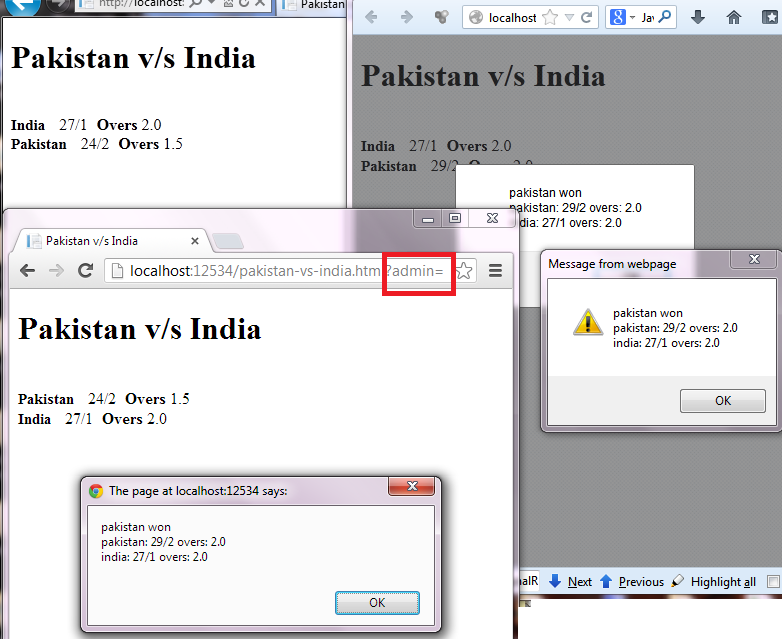Вступление:
Я из Пакистана. Как и большинство пакистанцев, я также большой поклонник крикета. Вчера я получил немного времени от своей занятой работы. Я подумал создать простую функцию Cricket Live Score, используя ASP.NET SignalR. Интересно также отметить, что ребята (Дэвид Фаулер из Вест-Индии и Дамиан Эдвардс из Австралии), которые активно участвуют в разработке SignalR, также являются фанатами крикета (поправьте меня, если я ошибаюсь). В этой статье я покажу вам, как создать простую функцию «Live Cricket Score» с помощью SignalR. Для быстрой демонстрации просто откройте эту ссылку в разных браузерах и в одном браузере просто добавьте ? Admin = query-string (которая станет администратором, который обновляет счет), затем просто нажмите Обновить счет Нажмите кнопку несколько раз, пока не закончится 2 кадра (матч будет ограничен 2 кадрами). Для каждого клика текущий счет будет обновляться в каждом браузере.
Описание:
Если вы новичок в SignalR, то Начало работы подойдет вам. Предполагая, что вы настроили ваше приложение с ASP.NET SignalR. Давайте создадим простую HTML-страницу со следующими строками:
<!DOCTYPE html>
<html>
<head>
<title>Pakistan v/s India</title>
<style>
.team
{
font-size: 15px;
padding-right: 10px;
font-weight: bold;
text-transform: capitalize;
}
.wickets,overs
{
padding-right: 5px;
}
</style>
</head>
<body>
<h1>Pakistan v/s India</h1>
<div id="updateScore" style="display: none;">
<input type="button" id="updateScoreLink" value="Update Score"/>
</div>
<br />
<div data-bind="foreach: teams">
<div>
<span class="team" data-bind="{ html: team }"></span>
<span class="runs" data-bind="{ html: runs }"></span>/<span class="wickets" data-bind="{ html: wickets }"></span>
<b>Overs</b> <span class="overs" data-bind="{ html: oversText }"></span>
</div>
</div>
<script src="Scripts/jquery-1.8.2.min.js" ></script>
<script src="Scripts/jquery.signalR-1.0.1.min.js"></script>
<script src="signalr/hubs"></script>
<script src="Scripts/knockout-2.2.0.js" ></script>
<script type="text/javascript">
// Here we start
</script>
</body>
</html>
In the above page, we have referenced jquery, signalr and knockout scripts. We have also define a simple template which will show the runs, wickets and overs of both teams. For demo purpose, we have added a Update Score button in the page. This button when clicked will record a single ball of an over as well as runs scored in this ball . After each ball, I will tell SignalR to broadcast teams score-card across all the connected client. When the match finished(after 24 balls), I will again tell the SignalR to show the final result to all users. Here are the scripts which are required for our work,
$(function () {
var chat = $.connection.cricketHub,
viewModel = {
teams: ko.observableArray([
{ team: 'india', runs: 0, wickets: 0, balls: 0, oversText: '0.0' },
{ team: 'pakistan', runs: 0, wickets: 0, balls: 0, oversText: '0.0'}])
},
index = 0;// index represant the position of the current batting team
chat.client.updateScore = function (t) {
viewModel.teams(JSON.parse(t));
};
chat.client.matchFinished = function (result) {
alert(result);
};
$.connection.hub.start().done(function () {
$('#updateScoreLink').click(function () {
var teams = viewModel.teams(),
team1 = teams[index],
team2 = teams[(index + 1) % 2],
wicketFalled = getRandomInt(0, 5) == 3 ? true : false;
// Assuming that the wicket will only fall when a 0-5 random number is 3
team1.runs += getRandomInt(0, 6); // Get a random score between 0 to 6
team1.wickets += wicketFalled ? 1 : 0;
team1.balls += 1;
team1.oversText = truncate(team1.balls / 6).toString() + '.' + (team1.balls % 6).toString();
chat.server.updateScore(JSON.stringify(teams));
if (team1.balls === 12 && team2.balls === 12) {
$('#updateScoreLink').hide();
var message = (team1.runs > team2.runs ? team1.team : team2.team) + ' won';
message = team1.runs === team2.runs ? 'match tied' : message;
message += '\n' + team1.team + ': ' + team1.runs + '/' + team1.wickets + ' overs: ' + team1.oversText;
message += '\n' + team2.team + ': ' + team2.runs + '/' + team2.wickets + ' overs: ' + team2.oversText;
chat.server.matchFinished(message);
}
else if (team1.balls === 12) {
index = 1;// second team batting
}
viewModel.teams([team1,team2]);
});
});
ko.applyBindings(viewModel);
if (isAdmin()) {
$('#updateScore').show();
}
function getRandomInt(min, max) {
return Math.floor(Math.random() * (max - min + 1)) + min;
}
function truncate(n) {
return Math[n > 0 ? "floor" : "ceil"](n);
}
function isAdmin(){
// For demo, assuming that only admin can update the score
// and the admin will be user which have admin querystring.
return location.href.indexOf('admin=') > -1
}
});
In the above scripts, we are initializing SignalR hub cricketHub object(we will see this hub class shortly), viewModel object which include team information(runs, wickets, etc) and index which represent the current batting team. Next, we have two client functions(updateScore and matchFinished) which will be invoked when the server broadcast a message to all clients.
When the hub start, we are registering event handler Update Score click event where we are getting a random run between 0-6, a wicket or not depending upon a random number, updating our view-model and then telling SignalR to broadcast the view-model across all the connected clients so that all clients automatically update their scorecard. Finally, when both teams completed their 12 balls, we will send the results to all the connected clients using SignalR. Note that for demo purpose we are only showing the Update Score button to the user which have admin= query-string.
Finally, here is our CricketHub class,
public class CricketHub : Hub
{
public void UpdateScore(string teams)
{
Clients.All.UpdateScore(teams);
}
public void MatchFinished(string result)
{
Clients.All.MatchFinished(result);
}
}
Summary:
In this article, I showed you one of the usage of ASP.NET SignalR. You have seen that how easily we can create a real-time Live Cricket Score using the power of ASP.NET SignalR which works in every browser . Hopefully you will enjoy my this article too.
